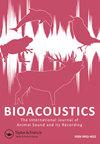使用自动被动记录仪评估圈养狼的自发嚎叫率
IF 2.1
4区 生物学
Q2 ZOOLOGY
Bioacoustics-The International Journal of Animal Sound and Its Recording
Pub Date : 2021-12-17
DOI:10.1080/09524622.2021.2006083
引用次数: 2
摘要
摘要:我们在明尼苏达州的国际狼群中心(IWC)(2019年春季和2020年冬季)和西班牙的洛博·伊贝里科·费利克斯·德拉富恩特中心(CLIFRF)(2020年冬天)研究了圈养狼的自发发声行为。我们使用AudioMoth录音设备每天24小时记录狼嚎。我们确定了412个单独的嚎叫系列和403个合唱嚎叫,并发现了这两个中心的狼之间的差异。IWC的北美狼叫声率(春季7.8次,冬季4.8次)高于CLIFRF的伊比利亚狼的叫声率(冬季3.8次)。在我们的研究中获得的嚎叫率与圈养的墨西哥狼相似,高于野生狼的报告。呼啸声的小时分布在各个中心之间也有所不同。IWC发现最大的啸叫活动发生在日出前,而CLIFRF则在日落时达到峰值。天气条件对我们研究的圈养狼的发声行为几乎没有影响。我们展示了被动录音机在研究动物声学通信主题方面的潜力,如语速和时间模式,由于技术限制,这些主题尚未得到深入解决。本文章由计算机程序翻译,如有差异,请以英文原文为准。
Assessing spontaneous howling rates in captive wolves using automatic passive recorders
ABSTRACT We studied the spontaneous vocal behaviour of captive wolves at the International Wolf Center (IWC) in Minnesota (spring 2019 and winter 2020), and the Centro del Lobo Ibérico Félix Rodríguez de la Fuente (CLIFRF) in Spain (winter 2020). We used AudioMoth recording devices to record wolf howling 24 h/day. We identified 412 solo howl series and 403 chorus howls and found differences between wolves at the two centres. Vocal rates for North American wolves at the IWC (7.8 chorus howls/day in spring and 4.8 chorus howls/day in winter) were higher than rates obtained for Iberian wolves from CLIFRF (3.8 chorus howls/day in winter). Howling rates obtained in our study were similar to those obtained for captive Mexican wolves and greater than those reported for wild wolves. Hourly distribution of howling was also different between centres. The greatest howling activity identified at IWC was at pre-sunrise, while at CLIFRF the peak occurred at sunset. Weather conditions had little influence on the vocal behaviour of the captive wolves we studied. We show the potential of passive recorders to study topics of animal acoustic communication, such as vocal rates and temporal patterns, that have not been deeply addressed due to technological constraints.
求助全文
通过发布文献求助,成功后即可免费获取论文全文。
去求助
来源期刊
CiteScore
4.50
自引率
0.00%
发文量
25
审稿时长
>12 weeks
期刊介绍:
Bioacoustics primarily publishes high-quality original research papers and reviews on sound communication in birds, mammals, amphibians, reptiles, fish, insects and other invertebrates, including the following topics :
-Communication and related behaviour-
Sound production-
Hearing-
Ontogeny and learning-
Bioacoustics in taxonomy and systematics-
Impacts of noise-
Bioacoustics in environmental monitoring-
Identification techniques and applications-
Recording and analysis-
Equipment and techniques-
Ultrasound and infrasound-
Underwater sound-
Bioacoustical sound structures, patterns, variation and repertoires

 求助内容:
求助内容: 应助结果提醒方式:
应助结果提醒方式:


